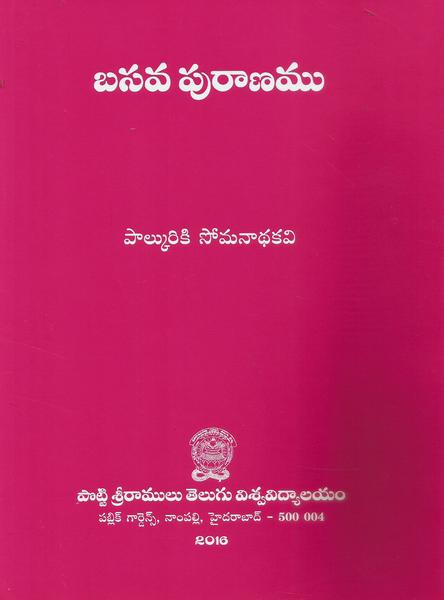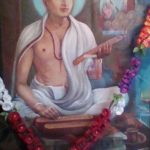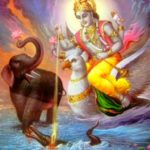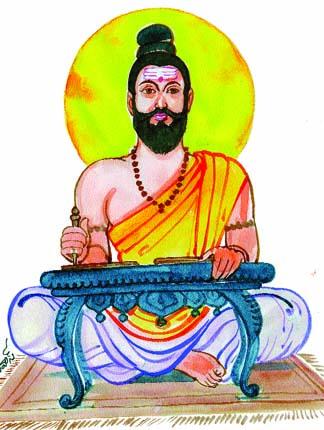
The next figure in our Continuing Series on Andhra Personalities, is one who is an almost iconoclastic original. In the annals of Telugu literature is one litterateur who stands astride the corpus as an ignored colossus.
“If Nannaya Bhattaraka of the 11th century AD is considered as the first and foremost Telugu poet, Palkuriki Somanatha of the 12th century is regarded as a pioneer and an epoch maker because Somanatha’s major works Basava Purana and Panditaradhya Charitra are original Telugu texts whereas Nannaya’s work is a translation of the Sanksrit Vyasa Maha Bharata.” [1]
Background
The name Palkuriki Somanatha is one that is known,yet not known as well as it should be. This Telugu auteur’s life and legacy to literature, nevertheless, begins in Telangana. “In his Basava Purana Somanatha mentions that his father and mother were Vishnu Ramideva and Sriyadevi“. [1, 23] His father’s name is almost poetically ironical, given that Somanatha would dedicate his life with zeal to the doctrinaire Veerashaiva Sampradaya.
Regardless, it is though that the Mahakavi lived from 1140 to 1240 CE, making this centenarian an epoch strider as much as an epoch maker. Karasthali Somanathayya is said to have been his instructor in poetry. [3] His orthodox origins are furthered affirmed in his Panditaradhya Charitra, where he noted that he was a a scholar in the four vedas (“nali palukriki somanathaumdanaga velayuvadanu, jaturveda paragunda“) [1, 64]. From his literary works, his knowledge of Sangeeta Saastra is apparent as well.
There has been much revisionism in recent years. Competing claims for credit often occlude the truth, or even the quest for it. Such claims have not left even an august figure like Palkuriki Somanatha. While neighbouring regions have sought to claim him due to his outstanding contributions to the Veerashaiva Sampradaya, he is undoubtedly a Telugu.
“Somanatha was an Andhra by origin. It is very clearly substantiated in his Telugu poetry works. This Kavisekhara was born in a small village named Palkuriki which was about 20 miles from the then capital Orugallu or Warangal of the Kakatiya kings.” [1, 8]
This Palkuriki village is today called Palkurthi, and is found in Jangaon Taluk, in Warangal district. There are Saasana Pramaanas (inscriptions) from the 12th and 13th centuries that refer to the villages of Elakuriki and Urukuriki, which are today also contracted to ‘Kurthi’. Palkurthi village also has an active Somanatha Devalaya to this day. [1, 8] Tellingly, Somanatha refers to an Aradhya brahmin, of Haarithasa gotra and Apastamba Sutra, named Suranna as his brother-in-law. Palkuriki Somanatha was himself an Aradhya who was later called a patita brahmana as he left the orthodox rules of Vedic Varnashrama dharma to take up the Veerashaiva Sampradaya, which opposed it. [1, 16]
“Basaveswara’s struggle to remove untouchability created a sensation in the traditional society” [1, 39]
Palkuriki Somanatha’s contributions in extolling Basava’s philosophy are inextricably attached to the reign of King Prataparudra I of the Imperial Kakatiyas. By his time, the dynasty had transitioned from Jain Dharma to the Veerashaiva movement. Prataparudra I was himself an author, having composed the Neethi Saara in Sanskrit and Telugu. Baddena would later refer to this book. [2, 51] In any event, there is an anecdote that connects this King to this Kavi.
According to Pidaparthi Somanatha’s Padya Basava Purana, Kakatiya Rudradeva came across some devotees reading Palkuriki’s Basava Purana at the Svayambunatha temple in Orugallu. The brahmanas there told him it was the work of “Soma Patita” (fallen Somanatha). “On hearing this Somanatha came to the capital of Kakatiyas i.e. Warangal, argued with his opponents, won his case and was honoured by Prataparudra. This could have been possible only if Somanatha stayed very close to Warangal“. [1, 10] While some assume this to be the famous Prataparudra II, Veturi Prabhakara Sastry states that this Kakatiya Rudra was the one who ruled in 1198 CE. This, in turn, establishes the approximate time period of the personality at hand.
A significant source on the life of Palkuriki is a scholar named Pidaparthi Somanatha. He is known for transforming the Dvipada Basava Puranamu into a Padya Kavya. The details provided therein give a rough sketch of the life of Palkuriki.
Somanatha’s Samadhi
While the outline of Palkuriki’s life remains sketchy, it is known that he had a son, and lived with his disciples at his eponymous village in Telangana. [1, 25]
Though a lingaikya (samaadhi) was constructed for Palkuriki Somanatha in his native Palkurthi village in modern Telangana, Tontadarya reports in his Somesvara Purana, that Somanatha attained kaivalya at Kalle village in Karnataka. This was due to the fact that a chaste woman named Chennamma lived there, and she wished to meet the great Veerashaiva scholar. That night, he is said to have had a dream where Lord Shiva appeared and told him the purpose of his life was completed. Palkuriki told all this followers this the next day, and preparations were made for him to leave his mortal coil in this Karnataka village itself. He passed while Panchakshari mantra was being recited, and a samaadhi for Somanatha still exists in Kalle. [1, 25]
Achievements
- Began “a renaissance in Telugu literature” through Saahithya Prakriyas
- Started the Desi literature trend in Telugu
- Wrote 2 Major Prose Poems, and a number of Minor Poems
- Raised awareness of Basavesvara and the Veerashaiva Philosophy
- A master of Poetics, Grammar, and Literature.
The achievements of Palkuriki Somanatha are myriad. He was Ashtabhaasha visarada, meaning equally proficient in 8 languages. He is considered a pioneer of Telugu Dvipada kaavya and udaharana category of literature. “Somanatha’s minor works can be divided into five categories. They are gadya, ragada, udaharana, panchaka and astaka types.” [1, 27]
“Udaharana is a form of literature of ‘sahitya prakriya’ like kavya, nataka, purana etc. This type of literature was first produced in Sanskrit by Palkuriki Somanatha and was later followed by other writers like Vidyanatha. Most of the udaharana works available in Sanskrit were written by Telugu writers. Udaharana is a laghu kavya consisting of 26 slokas. Vibhaktis are given importance.” [1, 31]
- 3 poems in each Vibhakti
- The first poem must be in 1 metre
- The second people must be of 1 ragada
- The third must have only 8 trimatra ganas.
- The ragadas and ardha ragadas are composed each in 8 padas
- The ragadas and ardha ragas are known as kalika and utkalika
This eminent Telugu personality had many accomplishments to his name. He is primarily known for gadya kaavya (prose poetry), as opposed to padya kaavya (verse poetry). Somanatha Bhaasya, Rudra Bhaasya, Anubhavasara, Vrshadipa Satakam, Panditaraadhya Charitra, and Basava Puranamu are the significant works of Palkuriki Somanatha. The latter, in particular, is considered his magnum opus.
Basava Purana
Basava Puranamu contains the biography of the great Veerashaiva philosopher. It is also conspicuous for not only being composed in Telugu, but featuring verses in a number of other languages as well (Marathi, Tamil, Kannada). [1, 64] Without a doubt, Basava Purana is the signal achievement of Palkuriki. Inspired by his namesake, “Piduparti Somanatha composed the Basava Purana in verse some time later (1510).” [1, 52]
“Basaveswara is not only a great scholar and preacher but one who in complete humility rests his head at the feet of Siva saranas. He is generous, shows compassion to those who move in the wicked path and are sinners.” [1, 44] Interestingly, Pandit Chelam garu has asserted the Andhra origins of Basava. If so, this would only underscore the case for Palkuriki Somanatha hailing from Telangana.
Panditaradhya Charitra
The other great opus in the grandhalaya of Palkuriki’s works is the Panditaradhya Charitra. It is an elegy on the life of Mallikarjuna Panditaradhya, another grand figure of the Veerashaiva Sampradaya. “The 12th century witnessed the emergence of Bhakti-centred Saivism, that is, Virasaivism which denounced the authority of Vedas…Mallikarjuna Pandita of Draksharama, a believer in Vedas, had effected a significant change in it. As a result the non-Vedic Virasaivism had acquired Vedic sanction and those Brahmins in Telugu region who followed this faith came to be known as Aradhyas.” [1, 75] Those who were non-Brahmins were called Jangamas. Regardless, the Panditaradhya Charitra extols Mallikarjuna and his contribution.
In it, “Somanatha mentions the 32 types of veenas, 15 types of strings, 22 types of gatis or sounds, 14 types of rachanas or compositions and 40 types of musical compositions. He gives the different vari[e]ties of talas, suddha talas, misra talas etc. As regards abhinaya or dance he lists out 70 main types of Abhinaya, 64 hand gestures, 108 karanas and 26 eye gestures.” [1, 74]
Other Contributions
“The earliest sataka we have is Vrisha-dipa Sataka, by Palakuriki Somanatha, in 1180.” [2, 99]
Vrshadhipa Sataka is a multi-lingual confluence. It consists of not only Sanskrit, but also Telugu, Tamil, Kannada, Marathi, and the Malayali Manipravala style (mixture of languages). Nevertheless, it is primarily in Telugu, with 80 of the 108 slokas in Andhra Bhaasha.
Of his minor works, Somanatha Bhaasya is probably the most significant.
“In Somanatha Bhasya he took quotations from srutis, smritis, puranas, itihasas, agamas, upanishads, etc. to suit his siddhanta and used them in his Bhasya in a particuar manner. Thus Somanatha Bhasya is not a commentary on any work. It speaks volumes about the greatness of Basava and establishes the acaras of Virashaivism“. [1, 55] As such, this work is also known as Basava-raajeeya and Veerashaiva Saroddhara. [1, 55]
Poesy is perhaps a matter for another time. Nevertheless, Palkuriki’s proficiency in Janu Telugu is a matter of signifiance. Janu Telugu is desi (provincial) Telugu that is in dvipada metre, and stands aparts from the marga style that was popular at the time. [1, 73] Long before Gidugu Ramamurthy, Palkuriki appears to have been a people’s champion of accessible language.
For posterity’s benefit, he provided a definition for Janu Telugu in a poem using Janu Telugu:
“Bhalu podatolu seereyunu papasarul gilupaadu kannu
Vennela talaseedu kuttu kayu nindina velupu teru valgu
Puusalu gala reni lenka vani jaanu tealnungu na sannu tin chedan
Velapu madindali basava basava basava vrushaadhipa” [1, 78]
Legacy
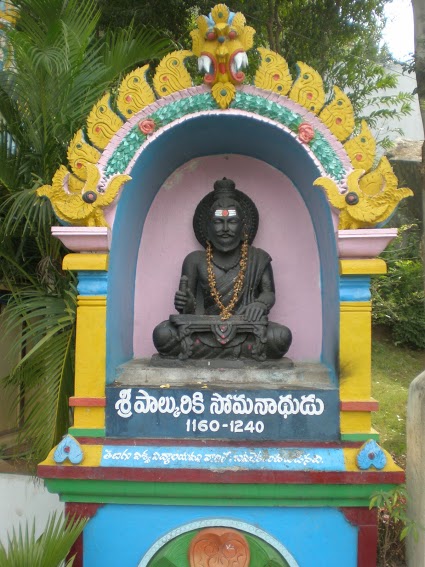
“Somanatha is a very great scholar who has mastered all these branches of learning. There is not a single technical work or sastra or veda which remains untouched by him…he quotes amply from Vedas, the Upanisads, the Puranas, the Agamas and the Sastras.” [1, 56]
Due to his significant impact on the Kannada canon, Somanatha is often thought to be a Kannadiga himself. Nevertheless, this Telugu left behind a prominent parampara of poets and philosophers who looked upon him as their guru. Some names include Gubbi Mallanarya (1515 CE) who wrote Veerasaivamruta Purana, Chaturmukha Hommarusu (1500 CE) of Revana Siddha Purana fame, Virupaksha Pandita (Chenna Basava Purana), Basavalinga Kavi (Sivadhikya Purana), and Santa Veera Desika (Sivalinga Charitra). [1, 67]
As for united Andhra, names of followers or imitators include Pidaparthi Somanatha, Pochiraju Veerakavi (Vibhuti Rudraksha Mahatmya, Srigiri Mallikarjuna Swami (Somavara Mahatmaya), Siddhayogi (Yogiswara Vilasa), Swami Veerabhadra (Kavi Simantini Katha), Chittaru Gangadhara kavi (Kolanupaka), and many others.[1, 66] In fact, Sreenatha Kavi Sarvabhauma is said to have been influenced himself, as there are similarities between the Basava Purana and the Hara Vilasa. Baddena too was said to have been another. Finally, “Somanatha had for his disciple the minister of Prataparudra Ninduturi Yannayamatya.” [2, 52]
The Basava Purana, in many ways, was this poet laureate’s signature masterpiece. “Palkuriki Somanath was completely successful in showing his deepest faith and devotion towards Basaveswara which he poured into this poetic work.” [1, 45] But we will conclude in his own words, which like Telugu literature, rose like the moon.
“Basavani sita keerti barvenaa sivuni
Bhasitanga raaga prabhulu barve naaga
Naarudra nallu haasaansulu danare
Naa raja tachala chaaru deedhitulu
Vilasille na na bhoveedhi neelladala
Nelakoni macchna vennela velliveriya”
Basava Purana 3rd canto [1, 78]
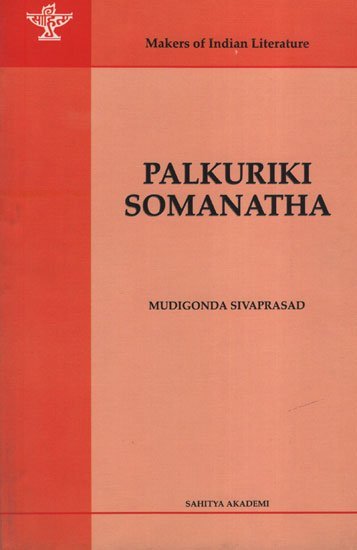
References:
- Mudigonda, Sivaprasad. Makers of Indian Literature: Palkuriki Somanatha. Delhi: Sahitya Akademi. 2011
- Bhujanga, Chenchiah. A History of Telugu Literature. Calcutta: Association Press. 1928
- Andhra Bhoomi. http://andhrabhoomi.net/content/main-feature-856
